ISO 27001 Certification Process and Requirements

How Does the ISO 27001 Certification Process Work? Detailed Explanation
What is the ISO 27001 Certification Process?
The ISO 27001 certification process is a series of steps followed by an organization to complete the implementation of its Information Security Management System (ISMS) and obtain confirmation of its compliance with international standards. This process is not only about obtaining a certificate but also a comprehensive roadmap aimed at continuous improvement of the organization’s information security practices. ISO 27001 is critically important for managing and safeguarding information security risks, and an organization that adopts this standard is on its way to building a stronger security framework.
The main stages of the ISO 27001 certification process are as follows:
Preparation Stage: The certification process begins with raising awareness of ISO 27001 within the organization. In the first step, the management of the organization should have adopted information security policies and possess sufficient awareness of the subject. Additionally, a decision should be made to establish an Information Security Management System (ISMS). At this stage, the organization should understand the requirements of ISO 27001 and evaluate how compatible its existing systems are with this standard. If the organization's current systems do not comply with ISO 27001, necessary improvements should be made.
Risk Assessment and Planning: The second stage of the ISO 27001 certification process is identifying and assessing risks. In this step, the organization identifies potential threats to information security and evaluates the impacts of these threats. Each risk is scored based on its likelihood and impact. As a result of the assessment, appropriate measures and policies should be developed to minimize the risks. Additionally, a plan should be created for monitoring and updating the risks. This stage lays the foundations for the information security strategy.
Preparation of ISMS Documentation: One of the most important steps of ISO 27001 is the preparation of the necessary documentation for the Information Security Management System. This documentation includes the organization’s information security policies, procedures, instructions, and records. The key documents required by ISO 27001 include risk assessment reports, asset inventories, business continuity plans, and incident management procedures. The documentation prepared for certification should comply with the requirements of ISO 27001.
Implementation and Training: After the documents are prepared, the requirements of ISO 27001 need to be implemented within the organization. In this stage, all personnel of the organization should be trained on the requirements of ISO 27001 and made aware of how to implement information security procedures. Trainings can be both theoretical and practical. Employees should have a clear understanding of their roles in information security management and should be involved in the practices.
Internal Audits and Review: The next stage of the certification process is conducting internal audits. The organization conducts internal audits to evaluate the performance of its information security management system. In internal audits, the effectiveness of information security procedures, asset security, risk management, and monitoring processes are reviewed. The results of internal audits help identify gaps and opportunities for improvement. This stage is crucial for the continuous improvement of information security.
External Audit and Certification: After internal audits, the organization undergoes an external audit by an accredited certification body. The external audit is conducted by an independent auditor and involves a detailed examination process to assess the organization’s compliance with the ISO 27001 standard. Auditors review the documentation and practices, checking the effectiveness and compliance of the system. If the organization meets all the requirements of ISO 27001, it is successfully certified and awarded the ISO 27001 certificate.
Continuous Improvement and Monitoring: ISO 27001 adopts the principle of continuous improvement. Even after the certification process is completed, the organization’s information security management system should be regularly monitored and updated. Whenever a security gap or risk arises, the organization should take immediate action to close the gap. This process ensures the long-term success of the organization’s information security.
As a certification body, we guide you step by step through the ISO 27001 certification process. We provide all the support you need to obtain the ISO 27001 certificate with our professional consulting services. Additionally, we help take all necessary steps together to establish and improve your organization’s information security management system.
